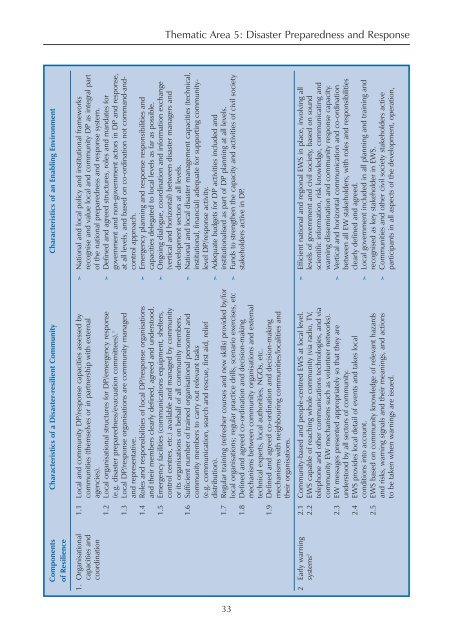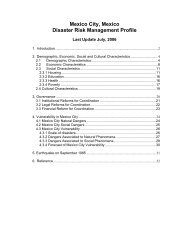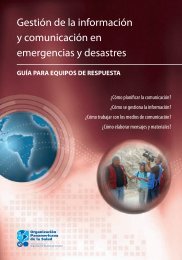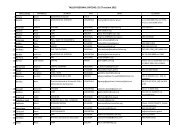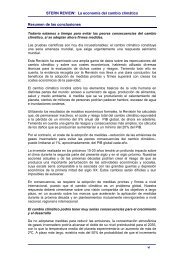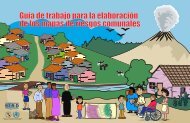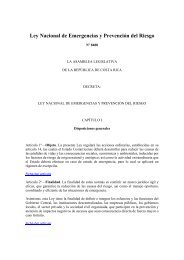Characteristics of a Disaster-resilient Community A ... - PreventionWeb
Characteristics of a Disaster-resilient Community A ... - PreventionWeb
Characteristics of a Disaster-resilient Community A ... - PreventionWeb
You also want an ePaper? Increase the reach of your titles
YUMPU automatically turns print PDFs into web optimized ePapers that Google loves.
Thematic Area 5: <strong>Disaster</strong> Preparedness and ResponseComponents <strong>Characteristics</strong> <strong>of</strong> a <strong>Disaster</strong>-<strong>resilient</strong> <strong>Community</strong> <strong>Characteristics</strong> <strong>of</strong> an Enabling Environment<strong>of</strong> Resilience1. Organisational 1.1 Local and community DP/response capacities assessed by ➣ National and local policy and institutional frameworkscapacities and communities (themselves or in partnership with external recognise and value local and community DP as integral partcoordination agencies). <strong>of</strong> the national preparedness and response system.1.2 Local organisational structures for DP/emergency response ➣ Defined and agreed structures, roles and mandates for(e.g. disaster preparedness/evacuation committees). 1 government and non-government actors in DP and response,1.3 Local DP/response organisations are community managed at all levels, and based on co-ordination not command-andandrepresentative. control approach.1.4 Roles and responsibilities <strong>of</strong> local DP/response organisations ➣ Emergency planning and response responsibilities andand their members clearly defined, agreed and understood. capacities delegated to local levels as far as possible.1.5 Emergency facilities (communications equipment, shelters, ➣ Ongoing dialogue, coordination and information exchangecontrol centres, etc.) available and managed by community (vertical and horizontal) between disaster managers andor its organisations on behalf <strong>of</strong> all community members. development sectors at all levels.1.6 Sufficient number <strong>of</strong> trained organisational personnel and ➣ National and local disaster management capacities (technical,community members to carry out relevant tasks institutional, financial) adequate for supporting community-(e.g. communication, search and rescue, first aid, relief level DP/response activity.distribution). ➣ Adequate budgets for DP activities included and1.7 Regular training (refresher courses and new skills) provided by/for institutionalised as part <strong>of</strong> DP planning at all levels.local organisations; regular practice drills, scenario exercises, etc ➣ Funds to strengthen the capacity and activities <strong>of</strong> civil society1.8 Defined and agreed co-ordination and decision-making stakeholders active in DP.mechanisms between community organisations and externaltechnical experts, local authorities, NGOs, etc.1.9 Defined and agreed co-ordination and decision-makingmechanisms with neighbouring communities/localities andtheir organisations.2 Early warning 2.1 <strong>Community</strong>-based and people-centred EWS at local level. ➣ Efficient national and regional EWS in place, involving allsystems 2 2.2 EWS capable <strong>of</strong> reaching whole community (via radio, TV, levels <strong>of</strong> government and civil society, based on soundtelephone and other communications technologies, and via scientific information, risk knowledge, communicating andcommunity EW mechanisms such as volunteer networks). warning dissemination and community response capacity.2.3 EW messages presented appropriately so that they are ➣ Vertical and horizontal communication and co-ordinationunderstood by all sectors <strong>of</strong> community. between all EW stakeholders, with roles and responsibilities2.4 EWS provides local detail <strong>of</strong> events and takes local clearly defined and agreed.conditions into account. ➣ Local government included in all planning and training and2.5 EWS based on community knowledge <strong>of</strong> relevant hazards recognised as key stakeholder in EWS.and risks, warning signals and their meanings, and actions ➣ Communities and other civil society stakeholders activeto be taken when warnings are issued. participants in all aspects <strong>of</strong> the development, operation,33


